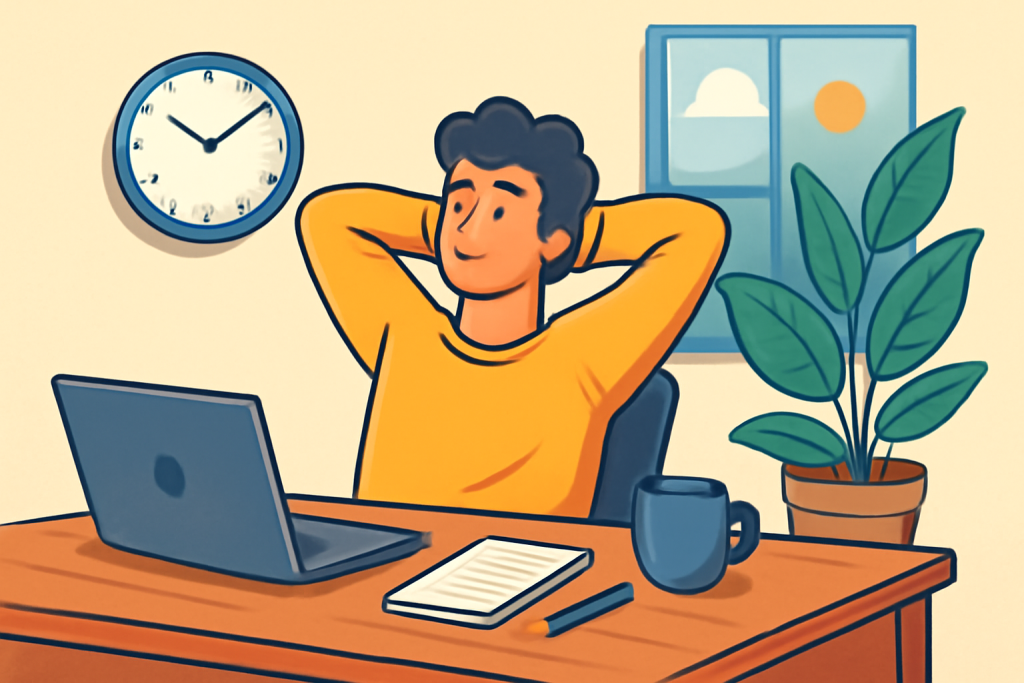In today’s productivity-obsessed culture, many professionals feel compelled to power through tasks without pausing. But pushing relentlessly isn’t always the path to high performance. More and more research supports the concept that intentional breaks increase output by replenishing mental energy, reducing stress, and enhancing cognitive function.
Whether you’re working in a fast-paced office or managing tasks from home, learning how to harness the power of strategic pauses could be the missing link to optimizing your day.

The Brain’s Limits: Why We Can’t Focus Forever
The human brain isn’t a machine—it’s a complex organ with finite energy reserves. Sustained cognitive effort drains those reserves, leading to declining performance, lower creativity, and more frequent mistakes.
A 2022 study from the Journal of Applied Psychology concluded that short breaks during mentally demanding tasks significantly reduce fatigue and maintain performance levels throughout the day (Wendsche & Lohmann-Haislah 2022). These findings align with long-standing cognitive psychology theories: we need downtime to maintain focus and accuracy.
Our brains operate on ultradian rhythms—natural cycles that fluctuate every 90 to 120 minutes. After a burst of focused activity, the brain needs time to recover. Ignoring these rhythms doesn’t improve productivity—it sabotages it.
The Pomodoro Technique: Structure Boosts Sustainability
One of the most popular frameworks for incorporating intentional breaks is the Pomodoro Technique, developed by Francesco Cirillo in the late 1980s. The method is simple but effective:
- Work for 25 minutes (a Pomodoro)
- Take a 5-minute break
- Repeat for four cycles, then take a longer break of 15–30 minutes
What makes Pomodoro so effective is its compatibility with how we naturally focus. It breaks the workday into digestible chunks, allowing the brain to maintain peak performance without exhaustion.
Research published in Applied Cognitive Psychology found that individuals using Pomodoro-style intervals retained more information and completed tasks more efficiently than those working continuously (Bailey & Konstan 2006). By adding structure to rest, it creates a sustainable work pattern that helps avoid burnout and procrastination.
Microbreaks: The Underrated Performance Hack
While Pomodoro involves planned pauses, microbreaks are even shorter and more spontaneous—lasting from 30 seconds to a few minutes. Think stretching, grabbing water, or simply closing your eyes for a moment.
Despite their brevity, microbreaks can produce outsized benefits. A 2021 study from North Carolina State University found that employees who took regular microbreaks reported lower levels of fatigue and higher work engagement (Zhang et al. 2021). These benefits were amplified when workers proactively took breaks before they felt mentally drained.
Effective microbreak activities include:
- Standing up and walking for 2 minutes
- Breathing exercises or meditation
- Looking at nature or a calming image
- Listening to music
These small resets give your brain just enough time to refocus, especially in cognitively demanding environments.
Breaks Prevent Burnout and Support Mental Health
Beyond productivity, breaks are essential for mental health. Constant exposure to digital screens, tight deadlines, and performance pressure can lead to chronic stress—a major contributor to anxiety, depression, and burnout.
Mental Health America highlights the importance of scheduled breaks in managing workplace stress, suggesting they improve emotional resilience and reduce psychological strain (Mental Health America 2023). In high-pressure jobs, the opportunity to mentally detach even briefly can be the difference between thriving and burnout.
Moreover, frequent short breaks have been shown to improve job satisfaction. They promote autonomy and self-care, both of which contribute to a more positive workplace experience.
Best Practices for Maximizing Your Breaks
To make the most of your intentional breaks, follow these best practices:
1. Set a Timer
Use timers or productivity apps to schedule both work intervals and break times. Apps like Focus Booster and Be Focused offer Pomodoro-based reminders.
2. Move Your Body
Physical activity, even minimal, boosts blood circulation and oxygenates the brain. Stand, stretch, walk—anything that gets you out of your chair.
3. Change the Scenery
If possible, step outside. Natural light and fresh air have proven restorative effects. Even looking out a window at greenery can help.
4. Avoid Screens
Don’t swap one screen for another. Try analog activities—read a book, jot thoughts in a journal, or close your eyes to rest them.
5. Stay Consistent
Like any habit, consistency is key. Make breaks a non-negotiable part of your day rather than a luxury to be earned.
Debunking the “Always-On” Myth
Many workers hesitate to take breaks, fearing it will be seen as laziness or lower commitment. But data shows the opposite: workers who take regular breaks often outperform their peers.
According to a 2023 survey by the American Psychological Association, over 65% of professionals said their productivity improved after implementing scheduled breaks into their routine. Moreover, companies that encourage intentional breaks report higher employee retention and better morale.
Rather than being indulgent, taking breaks is a practical strategy to safeguard your capacity to think clearly, work faster, and solve problems more creatively.
Intentional Breaks in the Hybrid Work Era
With the rise of remote and hybrid work, taking intentional breaks has become both easier and more challenging. At home, you might have more flexibility—but it’s also easier to work without stopping due to the absence of natural office cues like lunch breaks or watercooler chats.
To overcome this, remote workers should:
- Block break times in their digital calendars
- Set recurring reminders
- Use smartwatches or apps to prompt movement
Encouragingly, a 2023 study by Microsoft found that employees who took brief 10-minute breaks between virtual meetings experienced less stress and better engagement during the day (Microsoft Work Trend Index 2023).
Conclusion: Break to Build Better
Incorporating intentional breaks into your workday isn’t a time-waster—it’s a time-maximizer. Whether through the structured Pomodoro Technique or spontaneous microbreaks, pausing strategically helps recharge your brain, sharpen your focus, and avoid burnout.
As work continues to evolve, the ability to manage your energy—not just your time—will define success. Make intentional breaks a priority, and you’ll find yourself not only doing more, but doing it better.
References:
- Wendsche, J., & Lohmann-Haislah, A. (2022). Give me a break! A systematic review and meta-analysis on the effects of micro-breaks on well-being and performance. Journal of Applied Psychology. Available at: https://pmc.ncbi.nlm.nih.gov/articles/PMC9432722/
- Bailey, B. P., & Konstan, J. A. (2006). On the need for attention-aware systems: Measuring effects of interruption on task performance, error rate, and affective state. Applied Cognitive Psychology. Available at: https://onlinelibrary.wiley.com/doi/abs/10.1002/acp.1231
- Zhang, Y., Leung, D., & Salazar, C. (2021). Tired at the Office? Take a Quick Break. Your Work Will Benefit. North Carolina State University. Available at: https://news.ncsu.edu/2021/03/microbreaks-work-engagement/
- Mental Health America. (2023). Workplace Mental Health: Work-Life Balance. Available at: https://www.mhanational.org/work-life-balance
- Microsoft. (2023). Work Trend Index: Pulse on Hybrid Work. Available at: https://www.microsoft.com/en-us/worklab/work-trend-index/hybrid-work-pulse-report









